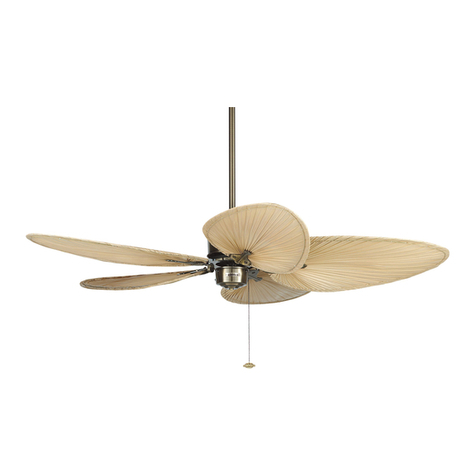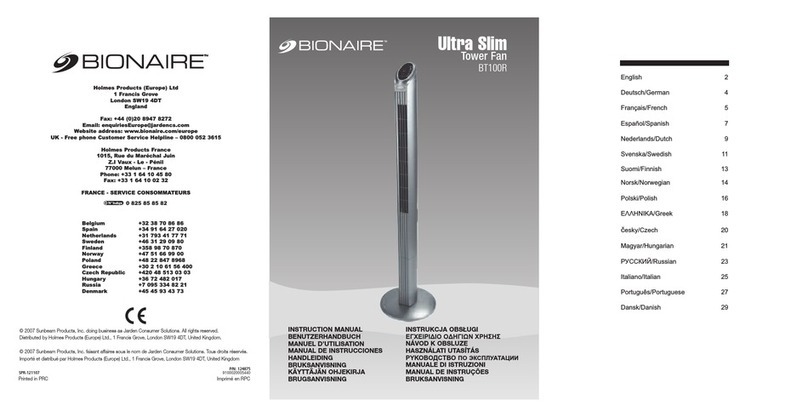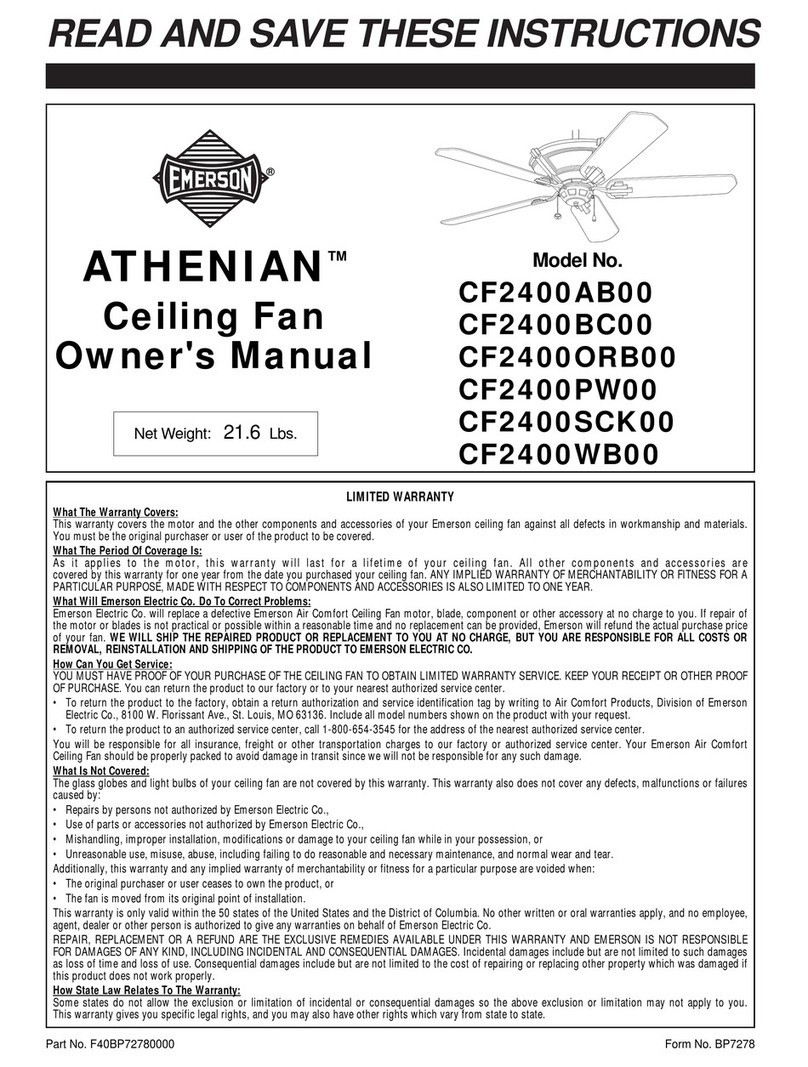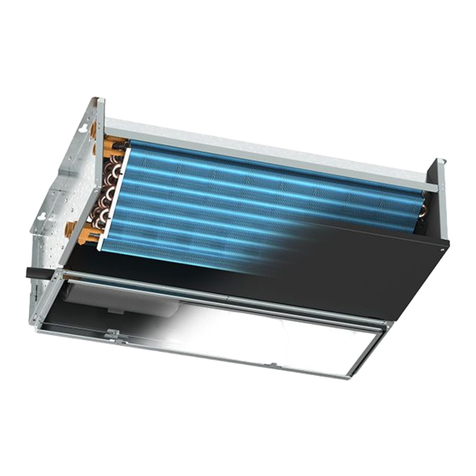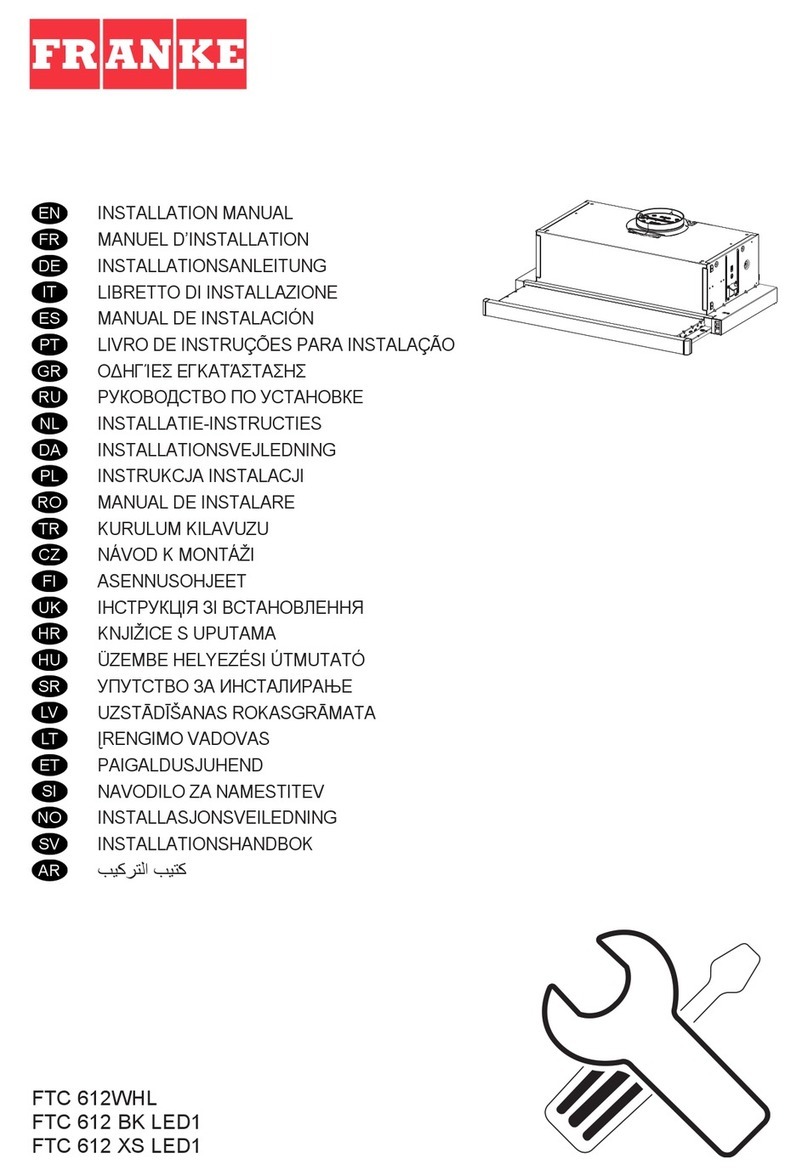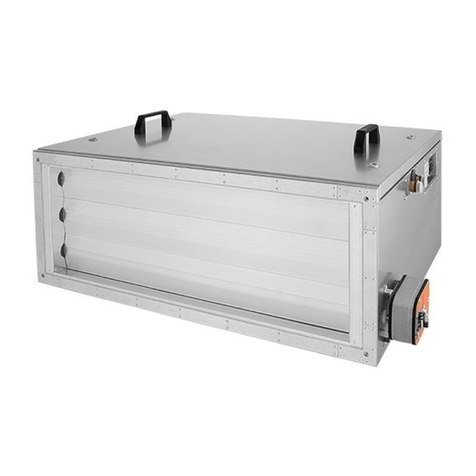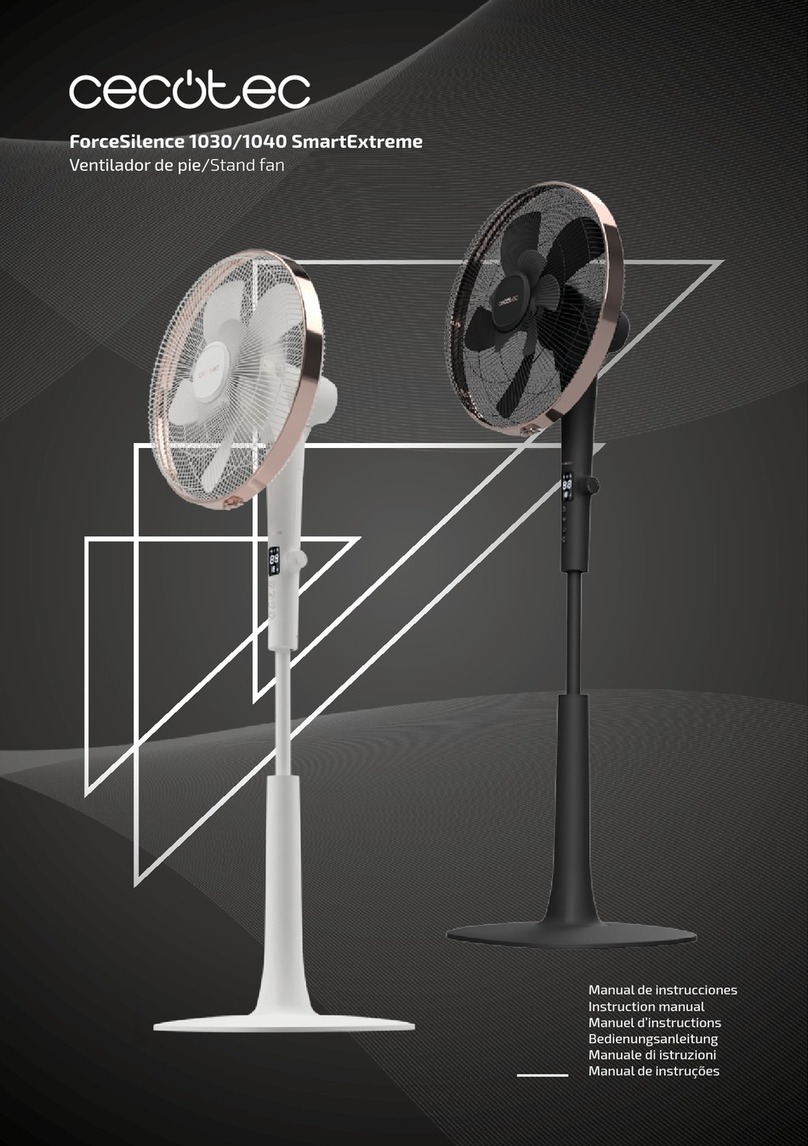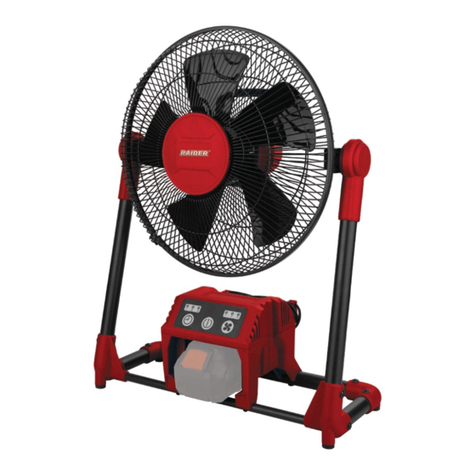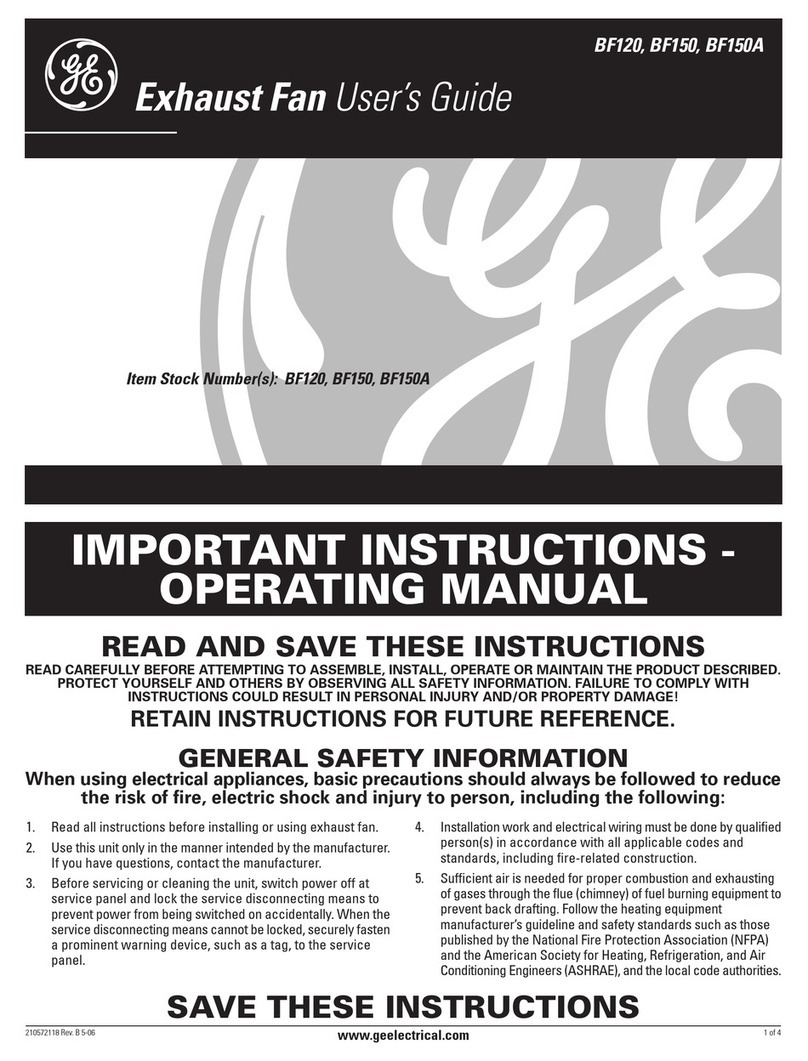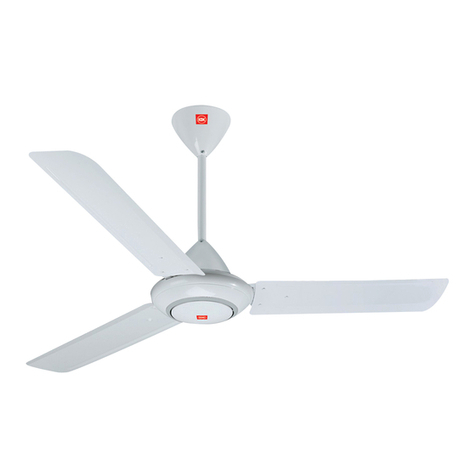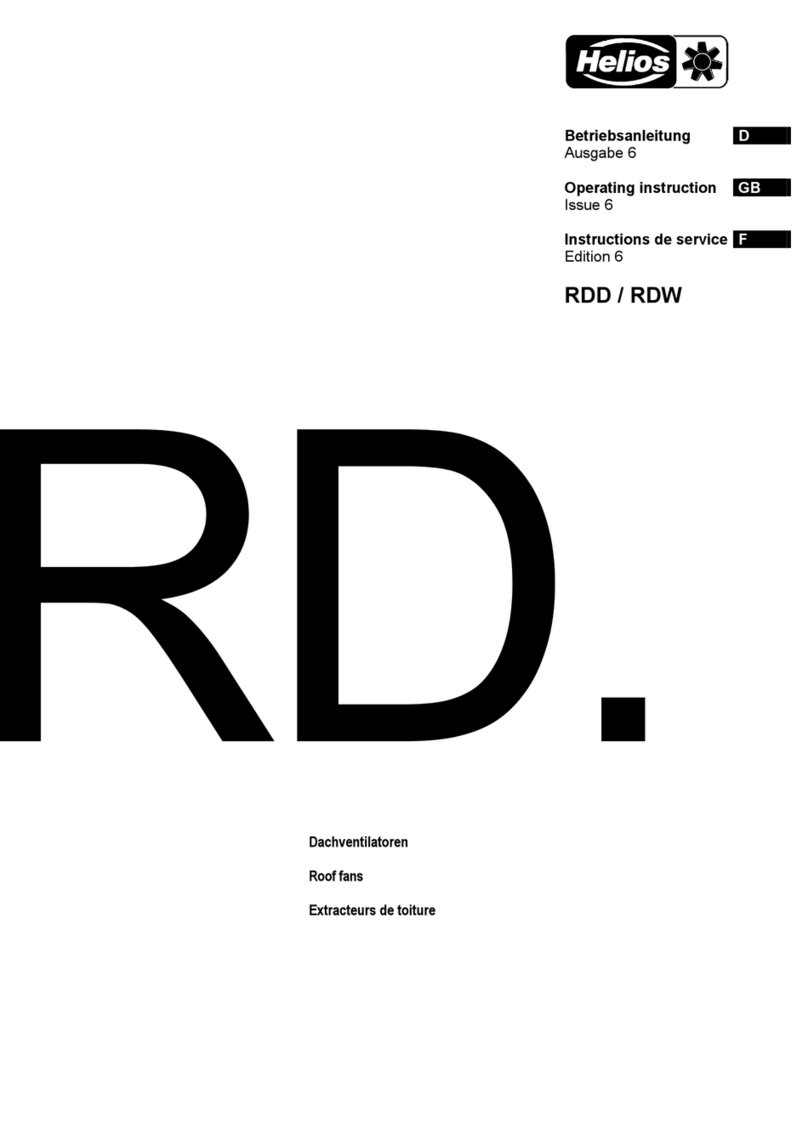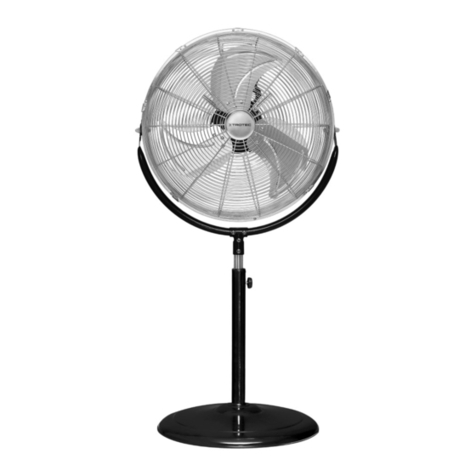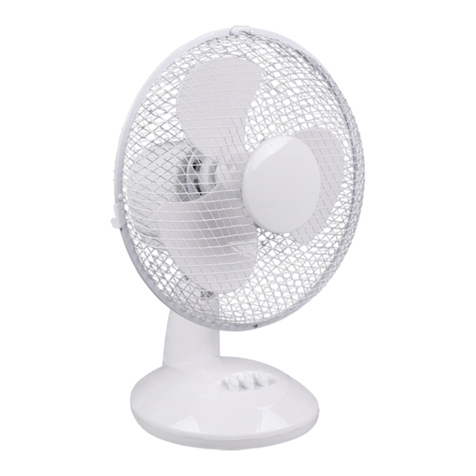Elington ANT54AV5WCR User manual

Installation Guide
net weight of fan: 37 lb. (16.78 kg) PRINTED IN CHINA
For Model:
ANT54AV5WCR
READ THESE INSTRUCTIONS AND
SAVE THEM FOR FUTURE USE
Table of Contents:
Safety Tips. pg. 1
Unpacking Your Fan. pg. 2
Parts Inventory. pg. 2
Installation Preparation. pg. 3
Hanging Bracket Installation. pg. 3
Fan Assembly. pgs. 4 - 5
Wiring. pgs. 5 - 6
Canopy Assembly. pg. 7
Scroll Arm Assembly. pg. 7
Blade Assembly. pg. 8
Switch Housing Assembly. pg. 8
Wall Control Operation. pg. 9
Testing Your Fan. pg. 9
Troubleshooting. pg. 10
Parts Replacement. pg. 10
Warranty. pg. 10
F.P.O.
F.P.O.
For Placement Only
For Placement Only

SAFETY TIPS.
page 1
WARNING: To reduce the risk of electrical shock, turn off the electricity to the fan at the main fuse box or circuit
panel before you begin the fan installation or before servicing the fan or installing accessories.
1. READ ALL INSTRUCTIONS AND SAFETY INFORMATION CAREFULLY BEFORE INSTALLING YOUR FAN
AND SAVE THESE INSTRUCTIONS.
CAUTION: To avoid personal injury, the use of gloves may be necessary while handling fan parts with sharp
edges.
2. Make sure all electrical connections comply with Local Codes or Ordinances, the National Electrical Code,
and ANSI/NFPA 70-1999. If you are unfamiliar with electrical wiring or if the house/building wires are
different colors than those referred to in the instructions, please use a qualified electrician.
3. Make sure you have a location selected for your fan that allows clear space for the blades to rotate, and at
least seven (7) feet (2.13 meters) of clearance between the floor and the fan blade tips. The fan should
be mounted so that the tips of the blades are at least thirty (30) inches (76 centimeters) from walls or
other upright structures.
4. The outlet box and ceiling support joist used must be securely mounted, and capable of supporting at
least 50 pounds (22,68 kilograms). The outlet box must be supported directly by the building structure.
Use only UL listed outlet boxes marked "FOR FAN SUPPORT."
WARNING: To reduce the risk of fire, electrical shock, or personal injury, mount to the outlet box marked
"Acceptable for Fan Support of 22.68 kg (50 lbs) or less," and use the mounting screws provided with the outlet
box. Most outlet boxes commonly used for the support of lighting fixtures are not acceptable for fan support
and may need to be replaced. Consult a qualified electrician if in doubt.
WARNING: To reduce the risk of fire, electrical shock, or personal injury, wire connectors provided with this fan
are designed to accept only one12 gauge house wire and two lead wires from the fan.If your house wire is larger
than 12 gauge or there is more than one house wire to connect to the corresponding fan lead wires, consult an
electrician for the proper size wire connectors to use.
5. Electrical diagrams are for reference only. Light kits that are not packed with the fan must be UL listed and
marked suitable for use with the model fan you are installing. Switches must be UL general use
switches. Refer to the instructions packaged with the light kits and switches for proper assembly.
6. After installation is complete, check that all connections are absolutely secure.
7. After making electrical connections, spliced conductors should be turned upward and pushed carefully up
into the outlet box. The wires should be spread apart with the grounded conductor and the
equipment-grounding conductor on opposite sides of the outlet box.
WARNING: To reduce the risk of electrical shock or fire, do not use this fan with any solid state speed control
device or control fan speed with a full range dimmer switch. [Using a full range dimmer switch to control fan
speed will cause a loud humming noise from fan.]
8. Do not operate the reverse switch until fan has come to a complete stop.[Note: If using remote control
with reverse capability, reverse fan blade direction only when on LOW speed.]
9. Do not insert anything between the fan blades while they are rotating.
WARNING: To reduce the risk of personal injury, do not bend the blade arms during assembly or after
installation. Do not insert objects into the path of the blades.
WARNING: To avoid personal injury or damage to the fan and other items,be cautious when working around or
cleaning the fan.
10. Do not use water or detergents when cleaning the fan or fan blades. A dry dust cloth or lightly dampened
cloth will be suitable for most cleaning.
WARNING: To reduce the risk of personal injury, use only parts provided with this fan. The use of parts OTHER
than those provided with this fan will void the warranty.
NOTE: The important safety precautions and instructions appearing in the manual are not meant to cover all
possible conditions and situations that may occur. It must be understood that common sense and caution are
necessary factors in the installation and operation of this fan.

2. Parts Inventory.
a. wall control and plate. 2 separate pieces
b. hanging bracket. 1 piece
c. canopy. 1 piece
d. 12in. downrod and hanging ball.1 piece
e. scroll arm. 3 pieces
f. yoke cover. 1 piece
g. scroll arm support. 1 piece
h. decorative downrod collar. 1 piece
i. switch housing plate. 1 piece
j. switch housing. 1 piece
k. motor housing. 1 piece
l. safety cable (already attached to motor).
1 piece
m. blade arm. 5 pieces
n. blade. 5 pieces
o. hardware packs
page 2
b
d
c
a
f
i
l
e
hj
mn
o
1. Unpacking Your Fan.
k
IMPORTANT REMINDER: You must
use the parts provided with this fan for
proper installation and safety.
Carefully open the packaging.Remove items
from Styrofoam inserts. Remove motor housing
and place on carpet or Styrofoam to avoid
damage to finish. Do not discard fan carton or
Styrofoam inserts should this fan need to be
returned for repairs.
Check against parts inventory that all parts have
been included.
g

3. Installation Preparation.
4. Hanging Bracket Installation
page 3
To prevent personal injury and damage,
ensure that the hanging location allows the
blades a clearance of 7ft. (2.13m) from the
floor and 30in. (76cm) from any wall or
obstruction.
This fan is suitable for room sizes up to 400
square feet (37.2 square meters).
This fan can be mounted with a downrod
on a regular (no-slope) or vaulted ceiling. The
hanging length can be extended by
purchasing a longer downrod (0.5in./1.27cm
diameter). Other installation, such as
flushmount, is not available for this fan.
Installation requires these tools:
Phillips screwdriver, flathead screwdriver,
adjustable pliers or wrench, stepladder, wire
cutters,and rated electrical tape.
Vaulted ceiling
angle is not to
exceed 25 degrees.
downrod
installation
flushmount
installation
12ft. - 20ft.
12ft. - 20ft.
(3.66m - 6.1m)
(3.66m - 6.1m)
7 feet
(2.13m)
(76cm)
30
inches
4. Hanging Bracket Installation.
ON
OFF
ON
OFF
hanging bracket
spring washers
outlet box screws
flat washers
Turn off circuit breakers to current fixture from breaker panel
and be sure operating light switch is turned to the OFF
position.
WARNING: Failure to disconnect power supply prior to
installation may result in serious injury.
Remove existing fixture.
WARNING: To reduce the risk of fire, electric shock, or personal
injury, mount to outlet box marked "Acceptable for Fan Support
of 22.68 kg (50lbs) or Less" and use mounting screws provided
with the outlet box. Most outlet boxes commonly used for the
support of lighting fixtures are not acceptable for fan support
and may need to be replaced. Consult a qualified electrician if in
doubt. When using an existing outlet box,be sure the outlet box
is securely attached to the building structure and can support
the full weight of the fan. Ensure outlet box is clearly marked
"Suitable for Fan Support." If not,it must be replaced with an
approved outlet box. Failure to do so can result in serious injury.
Install hanging bracket to outlet box,using original screws,
spring washers and flat washers provided with new or
original outlet box.* If installing on a vaulted ceiling, face
opening of hanging bracket towards high point of ceiling.
Arrange electrical wiring around the back of the hanging
bracket and away from the bracket opening.
*Note: It is very important that you use the proper hardware
when installing the hanging bracket as this will support the
fan.
blade edge

5. Fan Assembly.
If you wish to extend the hanging length of your fan,
you must remove the hanging ball from the 12in.
downrod provided to use with an extended downrod
(sold separately). [If you wish to use the 12in. downrod,
please proceed to instructions following the short dotted
line below.]
To remove the hanging ball, loosen set screw on
hanging ball, lower hanging ball and remove stop pin.
Slide hanging ball off of original downrod, A, and slide it
down the longer downrod, B (the top of the downrod
should be noted as having a set screw hole; use this hole
when setting the set screw). Insert stop pin into top of
extended downrod and raise hanging ball. Be sure stop
pin aligns with slots on the inside of the hanging ball.
Tighten set screw securely.
NOTE: The important safety precautions and instructions
appearing in the manual are not meant to cover all possible
conditions and situations that may occur. It must be
understood that common sense and caution are necessary
factors in the installation and operation of this fan.
page 4
canopy
scroll arm
support
decorative
downrod
collar
yoke cover
motor housing
yoke set screw
downrod
electrical wiring
clip
safety cable
vice
pin
Remove vice from safety cable by loosening the screw
and nut on the vice.
Tip: To prepare for threading electrical wires through
downrod, apply a small piece of electrical tape to the
ends of the electrical wires--this will keep the wires
together when threading them through the downrod.
Loosen yoke set screws and nuts at top of motor and
remove pin and clip from yoke at top of motor. Be sure set
screw in scroll arm support is loosened and that notches in
scroll arm support face upward. Slide downrod through
canopy, decorative downrod collar, scroll arm support
and yoke cover.
Thread safety cable and electrical wires through
downrod and pull extra wire slack from the upper end of
the downrod.
Thread downrod into the motor housing yoke until holes
for pin and clip in downrod align with holes in
yoke--make sure wires do not get twisted. Re-insert pin and
clip that were previously removed. Securely tighten yoke
set screws and nuts. Lower yoke cover to motor housing.
Remove blade arm screws and lock washers from
underside of motor and then remove stabilization plate.
Important: Stabilization plate may be discarded once
removed but save blade arm screws and lock washers for
later use.
["Fan Assembly" continued on next page.]
stabilization plate
blade arm
screws and
lock washers
set screw hole
set screw
hanging ball
stop pin
A
B

5. Fan Assembly. (cont.)
page 5
6.Wiring.
motor housing
safety cable
wood screw
and washer
safety cable loop
nut
screw
Tip: Code switches in the first part of Section 6
can be set on the top of the motor housing prior
to hanging the fan.
With the hanging bracket secured to the outlet
box and able to support the fan, you are now
ready to hang your fan. Grab the fan firmly with
two hands. Slide downrod through opening in
hanging bracket and let hanging ball rest on the
hanging bracket. Turn the hanging ball slot until it
lines up with the hanging bracket tab.
WARNING: Failure to align slot in hanging ball
with tab in hanging bracket may result in serious
injury or death.
Suggestion: Seek the help of another person to
hold the stepladder in place and to lift the fan up
to you once you are set on the ladder.
Find a secure attachment point (wood ceiling joist
highly recommended) and secure the safety
cable. It will be necessary to use a heavy duty
wood screw, washer and lock washer (not
supplied) with the safety cable loop. Extra cable
slack can be left in ceiling area.
Replace vice on safety cable and adjust safety
cable length by pulling on the cable. Adjust slack
in cable to a hands length and secure vice by
tightening screw and nut securely. [Refer to
drawing at right.]The loop at the end of the safety
cable should just fit over the threads on the wood
screw. Test safety cable by pulling on loose end with
pliers. If the safety cable slips, the vice and nut must
be set tighter.
hanging ball slot
hanging bracket tab
Use a ballpoint pen or a small screwdriver to set
the code switches for the wall control, and
built-in receiver so that they match. Factory
setting is pre-set and not recommended for use.If
your wall control interferes with other appliances,
change to another matching code on the wall
control and built-in receiver.
["Wiring" continued on next page.]
wood
ceiling
joist
code switches
wall control
motor housing
1234

page 6
black (OUT to fan)
green
black
(AC IN from
breaker box)
black
(TO POWER supply)
black
green/
green/
bare
bare
ground
ground
green/
bare
ground
outlet box wall
control
plate
code
switches
6.Wiring. (cont.)
CAUTION: Be sure outlet box is properly grounded
and that a ground (GREEN or Bare) wire is present.
Make sure all electrical connections comply with
Local Codes or Ordinances and the National
Electrical Code. If you are unfamiliar with electrical
wiring or if the house/building wires are different
colors than those referred to in the instructions,
please use a qualified electrician.
Note: Excess lead wire length from the fan can be
cut to the desired length and then stripped.
When downrod is secured in place on the
hanging bracket, electrical wiring can be
made as follows:
Connect BLACK wire from fan to BLACK wire
from ceiling with wire connector provided.
Connect WHITE wire from fan to WHITE wire
from ceiling with wire connector provided.
Connect all GROUND (GREEN) wires together
from fan to BARE/GREEN wire from ceiling with
wire connector provided.
* Wrap each wire connector separately with
electrical tape as an extra safety measure.
IN ORDER TO WIRE WALL CONTROL, remove
existing wall switch.
After codes have been properly set according to
"Wiring" instructions on previous page, wire the
WALL CONTROL with wire connectors provided
as shown in diagram at right.
* Wrap each wire connector separately with
electrical tape as an extra safety measure. Gently
push wires and taped wire connectors into outlet
box.
Attach wall control to outlet box and secure with
screws from original wall switch.Attach front
plate to wall control using 2 screws provided in
the wall control.
black
black
white
white
black supply wire
ground
(green
or bare)
white supply wire
from ceiling
from fan
ground
(green or bare)
*
1234

page 7
8. Scroll Arm Assembly.
Locate 3 pairs of scroll arm screws in top of
motor housing and remove.
Align holes in the small plate at the bottom of
one of the scroll arms with a pair of the scroll
arm screw holes in the top of the motor
housing.Re-insert 2 scroll arm screws that
were previously removed and then slip tab at
top of scroll arm into one of the slots on the
scroll arm support. Repeat with remaining
scroll arms.
Once all 3 scroll arms are set, tighten set
screw on scroll arm support and then tighten
all scroll arm screws securely. Lower
decorative downrod collar to scroll arm
support, aligning notches in decorative
downrod collar with posts on scroll arm
support. Press down gently on decorative
downrod collar to secure.
decorative
downrod
collar
canopy
set screw
scroll
arm
scroll arm
screws
scroll arm
support
motor housing small
plate
7. Canopy Assembly.
hanging bracket
canopy
Locate 2 screws on underside of hanging bracket
and remove screw closest to the open end of the
hanging bracket. Partially loosen the other screw.
Lift canopy to hanging bracket. Place rounded
part of slotted hole in canopy over loosened
screw in hanging bracket and push up.Twist
canopy to lock. Re-insert screw that was removed
and then tighten both screws securely.

page 8
10. Switch Housing Assembly.
switch housing plate
switch housing
motor
housing
Remove 3 screws from fitter plate (on underside
of motor). Align holes in middle of switch
housing plate with holes in fitter plate, allowing
wire connectors from motor housing to come
through hole in middle of switch housing plate.
Re-insert screws that were previously removed
and tighten all 3 screws securely.
*Wrap each wire connector separately with
electrical tape as an extra safety measure.
Remove 4 screws from outer edge of switch
housing plate.
Align holes in switch housing with holes in
switch housing plate. Re-insert screws that were
just removed and securely tighten all 4 screws
with Phillips screwdriver.
fitter plate
9. Blade Assembly.
motor
housing
blade
blade arm
Time Saver: Washers for blade screws can be
set on each blade screw prior to installing
blades.
Locate 15 blade attachment screws and
washers in hardware pack.Hold blade arm up
to blade and align holes.Insert 3 blade
attachment screws (along with washers) with
fingers first and then tighten screws securely
with Phillips screwdriver. Repeat procedure for
remaining blades.
Align blade arm holes with motor screw holes
and attach blade arm with lock washers and
blade arm screws that were previously
removed (page 4). Before securing screws
permanently, repeat this procedure with
remaining blade arms.Secure all screws.
Note:Tighten blade arm screws twice a year. blade arm screw
lock washer
blade
attachment
screws
and washers

12.Testing Your Fan.
page 9
It is recommended that you test fan before
finalizing installation. Locate ON/OFF slider switch
on wall control and set to the ON position. Test
light and dimmer function (if applicable) and then
test fan speeds with the different fan speed
buttons. If the wall control does not operate all of
the fan functions, refer to "Troubleshooting" section
to solve any issues before contacting Customer
Service.
Fan must be set on LOW before setting the fan in
reverse. Reverse blade rotation to recirculate air
depending on the season. A ceiling fan will allow
you to raise your thermostat setting in summer and
lower your thermostat setting in winter without
feeling a difference in your comfort.
11.Wall Control Operation.
ON/OFF slider switch - turns wall control ON or OFF
HI button - turns fan to HIGH speed
MED button - turns fan to MEDIUM speed
LOW button - turns fan to LOW speed
FAN OFF button - turns fan OFF
LIGHT button - (for use with optional light kit--sold
separately) turns light ON/OFF when
pressed once; dims light when pressed
and held down
REV button - used to REVERSE blade direction (fan
must be set on low before reversing
blade direction)

For parts and information, please refer to
"Parts Inventory" on page 2.
Ellington Customer Support:
1-800-486-4892
www.ellingtonfans.com
Troubleshooting.
page 10
Parts Replacement.
Warranty.
Problem: Fan fails to operate.
Solutions:
1. Check power to wall switch/wall control.
2. Check to be sure code switches in wall
control and receiver are set properly.
3.Verify that wall control is wired properly.
4.Verify that fan is wired properly.
Problem: Fan fails to operate with remote
control.
Solution:
Check to be sure code switches in wall control
and receiver are set properly.
Problem: Fan wobbles.
Solutions:
1. Use the balancing kit located in one the
hardware packs. If no blade balancing kit is
provided, please call Customer Support,
1-800-486-4892, to request one.
2. Check to be sure set screw(s) on motor
housing yoke is (are) tightened securely.
3. Check to be sure set screw on hanging ball
is tightened securely.
CRAFTMADE/ELLINGTON LIFETIME WARRANTY:
CRAFTMADE/ELLINGTON warrants this fan to the original
household purchaser for indoor use under the following
provisions:
1-YEAR WARRANTY: CRAFTMADE/ELLINGTON will replace
or repair any fan which has faulty performance due to a
defect in material or workmanship.Contact
Craftmade/Ellington Customer Service at 1-800-486-4892
to arrange for return of fan. Return fan, shipping prepaid, to
Craftmade/Ellington.We will repair or ship you a
replacement fan, and we will pay the return shipping cost.
5-YEAR WARRANTY: CRAFTMADE/ELLINGTON will repair or
replace at no charge to the original purchaser any fan
motor that fails to operate satisfactorily when failure
results from normal use.
RETURN FAN MOTOR ONLY, shipping prepaid,to
Craftmade/Ellington.We will repair or ship purchaser a
replacement motor and Craftmade/Ellington will pay the
return shipping cost.
6-YEAR to LIFETIME LIMITED WARRANTY:
CRAFTMADE/ELLINGTON will repair the fan, at no charge
for labor only to the original purchaser, if the fan motor
fails to operate satisfactorily when failure results from
normal use.Parts used in the repair will be billed to the
purchaser at prevailing prices at time of repair.
The purchaser shall be responsible for all costs incurred
in the removal, reinstallation and shipping of the product
for repairs.
This warranty does not apply when damage from
mechanical, physical, electrical or water abuse results in
causing the malfunction. Deterioration of finishes or other
parts due to time or exposure to salt air is specifically
exempted under this warranty.
Neither Craftmade/Ellington nor the manufacturer will
assume any liability resulting from improper installation or
use of this product. In no case shall the company be liable
for any consequential damages for breach of this, or any
other warranty expressed or implied whatsoever.This
limitation as to consequential damages shall not apply in
states where prohibited.

Indice de materias:
Sugerencias de seguridad. Pág. 1
Desempaquetado del ventilador. Pág. 2
Inventario de piezas. Pág. 2
Preparación para la instalación.Pág.3
Instalación del soporte de montaje.Pág.3
Ensamblaje del ventilador. Págs. 4 - 5
Instalación eléctrica. Págs. 5 - 6
Colocación de la cubierta decorativa.Pág. 7
Ensamblaje de los brazos con voluta. Pág.7
Colocación de las aspas. Pág. 8
Instalación de la caja de encendido. Pág. 8
Funcionamiento del control de pared. Pág. 9
Verificación del funcionamiento del
ventilador. Pág. 9
Localización de fallas. Pág. 10
Piezas de repuesto. Pág. 10
Garantía. Pág. 10
peso neto del ventilador: 16,78 kg (37 lb) IMPRESO EN CHINA
Guía de instalación
Para modelo:
ANT54AV5WCR
LEER ESTAS INSTRUCCIONES Y
GUARDARLAS PARA UTILIZACION FUTURA
F.P.O.
F.P.O.
For Placement Only
For Placement Only

página 1
SUGERENCIAS DE SEGURIDAD.
ADVERTENCIA: Para evitar la posibilidad de una descarga eléctrica, desconectar la corriente en la caja de fusibles
principal o el interruptor protector antes de iniciar la instalación del ventilador o antes de repararlo o instalar accesorios.
1. LEER TODAS LAS INSTRUCCIONES E INFORMACION DE SEGURIDAD CUIDADOSAMENTE ANTES DE INSTALAR
SU VENTILADOR Y GUARDAR ESTAS INSTRUCCIONES.
PRECAUCION: Para reducir el riesgo de daño corporal,es posible que sea necesario usar guantes al manejar las piezas
del ventilador que tengan bordes afilados.
2. Asegurarse de que todas las conexiones eléctricas cumplan con los Códigos o las Ordenanzas Locales, el Código
Nacional Eléctrico y ANSI/NFPA 70-1999. Si usted no está familiarizado con el alambrado eléctrico o los cables
de la casa/el edificio son de colores diferentes a los cuales se refieren en las instrucciones, favor de buscar un
electricista calificado.
3. Asegurarse de que haya localizado una ubicación para su ventilador que permite el espacio necesario para la
rotación de las aspas,y por lo menos 2,13 metros (7 pies) de espacio libre entre el piso y las puntas de las aspas.
Debe instalar el ventilador para que las puntas de las aspas queden a una distancia de por lo menos 76
centímetros (30 pulgadas) de las paredes y otras estructuras verticales.
4. La caja de salida eléctrica debe estar bien sujetada a la viga de soporte del techo y deben ser capaces de sostener
por lo menos 22,68 kilogramos (50 libras). La caja de salida debe tener apoyo directo de la estructura del
edificio. Sólo usar cajas de salida registradas con UL que indican que "sirven para ventilador" ("FOR FAN
SUPPORT" en inglés).
ADVERTENCIA: Para reducir el riesgo de incendio, descarga eléctrica o daño corporal, instalar en la caja de salida
marcada "Aceptable para sostener ventilador de 22,68 kg (50 lb) o menos" ["Acceptable for Fan Support of 22,68 kg
(50 lbs) or less"] y utilizar los tornillos proporcionados con la caja de salida. La mayoría de las cajas de salida que
normalmente se usan para sostener los aparatos de alumbrado no siempre son apropiadas para sostener ventiladores y
es posible que las tenga que reemplazar. En caso de duda, consultar con un electricista calificado.
ADVERTENCIA: Para reducir el riesgo de incendio, descarga eléctrica o daño corporal, los conectores para cable
provistos con este ventilador son diseñados para aceptar sólo un cable de calibre 12 de la casa y dos cables principales
del ventilador. Si el calibre del cable de la casa es superior al 12 o hay más de un cable de la casa para conectar a los
cables principales del ventilador al cual corresponda cada uno, consultar con un electricista para informarse sobre el
tamaño correcto de conectores para cable que se debe usar.
5. Los diagramas eléctricos son únicamente para referencia. Los juegos de luz que no se incluyen con el ventilador
deben tener el símbolo UL y también deben indicar que sirven para uso con este ventilador. Los interruptores
deben ser interruptores de uso general UL. Referirse a las instrucciones incluidas con el juego de luz y los
interruptores para ensamblarlos correctamente.
6. Después de haber terminado la instalación, asegurarse de que todas las conexiones estén totalmente seguras.
7. Después de haber terminado todas las conexiones eléctricas, los conductores empalmados deben ser volteados
para arriba y colocados cuidadosamente dentro de la caja de salida. Los alambres se deben de separar con el
conductor a tierra a un lado y el conductor a tierra del equipo al lado opuesto.
ADVERTENCIA: Para reducir el riesgo de incendio o una descarga eléctrica, no usar el ventilador con ningún control de
velocidad de estado sólido ni controlar la velocidad del ventilador con un interruptor con reductor de luz de gama
completa. [El usar un interruptor con reductor de luz de gama completa para controlar la velocidad del ventilador
causara un zumbido recio del ventilador.]
8. No utilizar el interruptor de reversa hasta que el ventilador se haya parado completamente. [Nota: Si se usa un
control remoto con capacidad de reversa,cambiar la dirección de las aspas sólo cuando el ventilador esté en
velocidad BAJA.]
9. No insertar ningún objeto entre las aspas mientras estén rotando.
ADVERTENCIA: Para reducir el riesgo de daño corporal, no doblar los brazos de las aspas durante el ensamblaje ni
durante la instalación. No insertar objetos entre las aspas mientras estén rotando.
ADVERTENCIA: Para reducir el riesgo de daño corporal o algún daño al ventilador, tener cuidado al estar trabajando
alrededor del ventilador o limpiándolo.
10. No utilizar agua ni detergentes para limpiar el ventilador ni las aspas. Usar un trapo seco o ligeramente húmedo
para su limpieza general.
ADVERTENCIA: Para reducir el riesgo de daño corporal,usar sólo las piezas provistas con este ventilador. Al usar
piezas DISTINTAS a las provistas con este ventilador se invalidará la garantía.
NOTA: No se debe concluir que las precauciones de seguridad importantes e instrucciones en este manual van a abarcar
todas las condiciones y situaciones posibles que puedan ocurrir. Se debe entender que el sentido común y la
precaución son factores necesarios en la instalación y la operación de este ventilador.

a. control de pared y placa.2 unidades distintas
b. soporte de montaje.1 unidad
c. cubierta decorativa. 1 unidad
d. tubo de 30,48cm y bola que sirve para colgar.
1 unidad
e. brazo con voluta. 3 unidades
f. cubierta del cuello. 1 unidad
g. soporte de los brazos con voluta. 1 unidad
h. cuello decorativo del tubo.1 unidad
i. placa de la caja de encendido. 1 unidad
j. caja de encendido. 1 unidad
k. bastidor del motor. 1 unidad
l. cable de seguridad (fijado de antemano al
motor). 1 unidad
m. brazo para el aspa.5 unidades
n. aspa. 5 unidades
o. paquetes de artículos de ferretería
página 2
1. Desempaquetado del ventilador.
a
2. Inventario de piezas.
Abrir el empaque cuidadosamente.Sacar los artículos
del embalaje.Sacar el motor y ponerlo en una
alfombra o en el embalaje para evitar rayar el acabado.
Guardar la caja de cartón o el empaquetamiento
original en caso de que tenga que mandar el
ventilador para alguna reparación.
Comprobar las piezas del ventilador con el inventario
de piezas y verificar que se incluyeron todas.
RECORDATORIO IMPORTANTE:
Se tienen que utilizar las piezas provistas
con este ventilador para una instalación
adecuada y su seguridad.
b
d
c
a
f
i
l
e
hj
mn
o
k
g

página
3
Se puede colgar este ventilador con tubo en un
techo regular (sin inclinación) o abovedado. La
longitud colgante se puede extender comprando
un tubo más largo (con diámetro de 1,27cm/0,5
pulg.). No hay ningún otro tipo de instalación, como
al ras con el techo, disponible para este ventilador.
3. Preparación para la instalación.
Para prevenir daño corporal y otros daños,estar
seguro de que el lugar en donde va a colgar el
ventilador le permite un espacio libre de 2,13m
(7 pies) entre las puntas de las aspas y el piso y
76cm (30 pulg.) entre las aspas y cualquier pared u
otra obstrucción.
Este ventilador es adecuado para habitaciones
hasta 37,2 metros cuadrados (400 pies cuadrados).
Se necesitan las herramientas siguientes para la
instalación:
Destornillador de estrella Phillips,destornillador de
paleta (plano), alicates ajustables o llave de tuercas,
escalera de tijera, cortaalambres y cinta aisladora.
borde del aspa
2,13m
(7 pies)
76cm
(30
pulg.)
3,66m - 6,1m
3,66m - 6,1m
12 pies - 20 pies
12 pies - 20 pies
instalación
con tubo instalación al ras
con el techo
El ángulo de
inclina-ción de un
techo abovedado no
debe exceder los 25
grados.
4. Instalación del soporte de montaje.
ON
OFF
ON
OFF
soporte de montaje
arandelas de resorte
tornillos de la
caja de salida
arandelas planas
Apagar los cortacircuitos en el panel de electricidad que suplen
corriente a la caja de salida y asegurarse de que el interruptor de luz
esté APAGADO.
ADVERTENCIA: El no desconectar el suministro de fuerza antes de la
instalación puede tener por resultado lesiones graves.
Quitar el aparato existente.
ADVERTENCIA: Para reducir el riesgo de incendio, descarga eléctrica, o
daño corporal, instalar el ventilador en una caja de salida marcada
como adecuada para sostener un ventilador de 22,68 kg (50 lb) o menos
y usar los tornillos de montaje provistos con la caja de salida. La mayoría
de las cajas de salida que se usan comúnmente para sostener aparatos
de alumbrado no son aceptables para ventilador y es posible que sea
necesario reemplazarla. Consultar con un electricista calificado en caso
de duda. Si utiliza una caja de salida eléctrica existente, asegurarse de
que la caja de salida esté firmemente conectada a la estructura del
edificio y que sea capaz de sostener el peso total del ventilador.
Asegurarse de que la caja de salida indique claramente que "Sirve para
ventilador" (FOR FAN SUPPORT); si no, se debe reemplazar con una caja
de salida aprobada. El no hacer el cambio si es necesario puede resultar
en lesiones graves.
Instalar el soporte de montaje utilizando los tornillos originales, las
arandelas de resorte y las arandelas planas de su nueva o existente
caja de salida.* Si hace la instalación en un techo abovedado, colocar
el soporte de montaje con la abertura dirigida hacia la parte alta del
techo. Arreglar el alambrado eléctrico (los cables) en la parte de atrás
del soporte y lejos de la abertura del soporte.
*Nota: Es muy importante usar los artículos de ferretería correctos al
instalar el soporte de montaje puesto que sirve para sostener el
ventilador.

página 4
soporte de
los brazos
con voluta
cuello
decorativo
del tubo
5. Ensamblaje del ventilador.
cubierta
del cuello
clavija
perno
cubierta
decorativa
bastidor
del motor
tornillo de
fijación del cuello
NOTA: No se debe concluir que las precauciones de seguridad
importantes e instrucciones en este manual van a abarcar todas las
condiciones y situaciones posibles que puedan ocurrir. Se debe
entender que el sentido común y la precaución son factores
necesarios en la instalación y la operación de este ventilador.
Si usted desea extender la longitud colgante del ventilador,
usted tendrá que quitar la bola que se sirve para colgar del
tubo de 30,48cm provisto para usarla con un tubo más largo (a
la venta por separado).[Si desea utilizar el tubo de 30,48cm, favor
de pasar a las instrucciones después de la línea punteada más
abajo.]
Para quitar la bola que sirve para colgar, aflojar el tornillo de
fijación de la bola que sirve para colgar, bajar la bola que sirve
para colgar y sacar el perno de tope. Quitar la bola que sirve
para colgar del tubo original, A, y deslizarla sobre el tubo más
largo, B (la parte de arriba del tubo debe tener el agujero para
el tornillo de fijación en ese extremo; usar ese agujero al
colocar el tornillo de fijación).Introducir el perno de tope en la
parte de arriba del tubo más largo y subir la bola que sirve para
colgar. Asegurarse de que el perno de tope se ponga en línea
con las ranuras dentro de la bola que sirve para colgar. Apretar
bien el tornillo de fijación.
Quitar el seguro del cable de seguridad aflojando el tornillo y la
tuerca en el seguro.
Sugerencia: Para preparar los cables para pasarlos por el tubo,
poner un pedacito de cinta aisladora en la punta de los
cables--esto mantendrá los cables juntos al pasarlos por el
tubo.
Aflojar los tornillos de fijación del cuello y las tuercas en la
parte superior del motor y quitar el perno y la clavija del cuello
en la parte superior del motor. Asegurarse de que el tornillo de
fijación en el soporte de los brazos con voluta esté aflojado y que
las muescas en el soporte de los brazos con voluta estén
orientadas hacia arriba. Pasar el tubo por la cubierta
decorativa, el cuello decorativo del tubo, el soporte de los
brazos con voluta y la cubierta del cuello.
Pasar los cables del ventilador y el cable de seguridad a través
del tubo y con cuidado jalar el cableado en exceso por la parte
de arriba del tubo.
Enroscar el tubo en el cuello del bastidor del motor hasta
alinearse los agujeros para el perno y la clavija en el tubo con
los del cuello—asegurarse de que no se tuerzan los cables.Volver
a introducir el perno y la clavija que se quitaron anteriormente.
Apretar los tornillos de fijación del cuello y las tuercas
completamente. Bajar la cubierta del cuello hasta el bastidor
del motor.
Quitar los tornillos para los brazos para las aspas y las arandelas
de seguridad del motor y luego quitar la placa de
estabilización.
Importante: La placa de estabilización se puede desechar
pero guardar los tornillos para los brazos para las aspas y las
arandelas de seguridad para usarlos más adelante.
[El "Ensamblaje del ventilador" continúa en la
página siguiente.]
cableado
tubo seguro
cable de
seguridad
placa de
estabilización
tornillos y arandelas
de seguridad para
fijar el brazo del aspa
B
A
bola que
sirve para
colgar
perno
de tope
tornillo
de fijación
agujero para
el tornillo
de fijación

página 5
bastidor
del motor
parte saliente del
soporte de montaje
ranura en la bola
que sirve para colgar
cable de
seguridad
tornillo para
madera y
arandela
tuerca
tornillo
bucle del cable
de seguridad
5. Ensamblaje del ventilador. (cont.)
Consejo útil:Los conmutadores de las unidades de
control remoto en la primera parte de la sección 6 se
pueden programar antes de colgar el ventilador.
Ya que esté sujetado el soporte de montaje a la caja de
salida y capaz de apoyar el ventilador, usted está listo
para colgar el ventilador. Agarrar el ventilador
firmemente con las dos manos.Deslizar el tubo por la
abertura del soporte de montaje y dejar que se detenga
la bola en el soporte de montaje.Girar la bola que sirve
para colgar hasta que la ranura de la bola se alinee con la
parte saliente del soporte de montaje.
ADVERTENCIA:El no alinear la ranura en la bola que
sirve para colgar con la parte saliente del soporte de
montaje puede causar lesiones graves o la muerte.
Sugerencia: Solicitar ayuda de otra persona para
mantener sujeto la escalera y para que le suba el
ventilador cuando usted ya esté preparado en la
escalera para colgarlo.
Encontrar un punto de acoplamiento seguro (se
recomienda la viga de madera en el techo) y asegurar el
cable de seguridad.Utilizar tornillo para madera para
trabajos pesados,arandela y arandela de seguridad (no
provistos) en el bucle del cable de seguridad. Se puede
poner el cable en exceso en el área del techo.
Volver a poner el seguro en el cable de seguridad y
ajustar el largo del cable de seguridad. Ajustar la parte
floja del cable para que mida como el largo de una mano
y asegurar el seguro apretando bien el tornillo y la
tuerca. [Referirse al diagrama al lado.] El bucle en el
extremo del cable de seguridad debe ser de tal tamaño que
pase justo sobre la punta de la parte roscada del tornillo
para madera. Poner el cable a prueba jalando la parte
suelta en la punta del cable con alicate.Si el cable se desliza
o se reduce el bucle del cable por donde pasa el tornillo,hay
que apretar el tornillo y la tuerca del seguro del cable
nuevamente.
6. Instalación eléctrica.
viga de
madera
Usar un bolígrafo o un destornillador pequeño para
programar los conmutadores de las unidades de
control remoto en el control de pared y el receptor
integrado para que sean iguales. Viene de la fábrica
en una posición predeterminada y no se recomienda
usarla. Si el control de pared interfiere con otros
enseres, cambiar a otro código en el control de
pared y el receptor integrado.
[La "Instalación eléctrica" continúa en la página
siguiente.]
bastidor del motor
1234
control de pared
conmutadores
de las unidades
de control remoto

página 6
6. Instalación eléctrica. (cont.)
PRECAUCION: Asegurarse de que la caja de salida esté
conectada a tierra como es debido y que exista un
conductor a tierra (VERDE o pelado).
Asegurarse de que toda conexión eléctrica cumpla con
los Códigos o las Ordenanzas Locales y el Código
Nacional Eléctrico. Si usted no está familiarizado con la
instalación eléctrica o los cables de la casa/el edificio son
de colores diferentes a los cuales se refieren a
continuación, favor de buscar un electricista calificado.
Nota: Si la longitud del alambrado que sale del
ventilador es demasiado, se puede cortarlo al largo
deseado y luego pelarlo.
Una vez que el ventilador esté bien sujeto en el
soporte de montaje, se puede hacer la instalación
eléctrica como sigue:
Conectar los cables NEGRO del ventilador al cable
NEGRO del techo con un conector para cable
provisto.
Conectar el cable BLANCO del ventilador al cable
BLANCO del techo con un conector para cable
provisto.
Conectar todos los conductores a TIERRA (VERDES)
del ventilador a los PELADOS/VERDES del techo con
un conector para cable provisto.
* Como una medida de seguridad adicional, envolver
cada conector para cable por separado con cinta
aisladora.
PARA HACER LA INSTALACION ELECTRICA DEL
CONTROL DE PARED, quitar el interruptor de pared
existente.
Después de programar los conmutadores según las
instrucciones de "Instalación eléctrica" en la página
anterior, alambrar el CONTROL DE PARED con los
conectores para cable provistos así como se muestra
en el diagrama al lado.
*Como una medida de seguridad adicional, envolver
cada conector para cable por separado con cinta
aisladora. Delicadamente meter los cables y los
conectores para cable que tienen cinta dentro de la
caja de salida.
Sujetar el control de pared a la caja de salida y
asegurarlo con los tornillos del interruptor de pared
original. Sujetar la placa delantera al control de pared
usando los 2 tornillos provistos con el control de
pared.
negro (AL ventilador)
verde
negro
(AL SUMINISTRO de fuerza)
negro
tierra
verde/
pelado
negro
(ENTRADA CA
del cortacircuitos)
caja de
salida control
de pared
placa
conmutadores
de las unidades
de control
remoto
toma de tierra
(verde o
pelada)
toma de tierra
(verde o
pelada)
negro
negro
blanco
blanco
alambre conductor negro
alambre conductor blanco
del techo
del
ventilador *
1234

página 7
8. Ensamblaje de los brazos con voluta.
brazo con
voluta
cubierta
decorativa
soporte de
los brazos
con voluta
cuello
decorativo
del tubo
tornillo de fijación
bastidor del motor
tornillos de
los brazos
con voluta
placa
pequeña
Localizar los 3 pares de tornillos para los brazos
con voluta en el lado superior del bastidor del
motor y sacarlos.
Alinear los agujeros en la placa pequeña en la
parte inferior de uno de los brazos con voluta con
un par de los agujeros para los tornillos de los
brazos con voluta en la parte superior del bastidor
del motor.Volver a introducir 2 tornillos para los
brazos con voluta que se quitaron anteriormente
y luego meter la parte saliente de la parte
superior del brazo con voluta en la ranura del
soporte de los brazos con voluta. Repetir con los
brazos con voluta restantes.
Una vez que los 3 brazos con voluta estén
puestos,apretar el tornillo de fijación del soporte
de los brazos con voluta y luego apretar bien
todos los tornillos de los brazos con voluta.Bajar
el cuello decorativo del tubo hasta el soporte de
los brazos con voluta, alineando las muescas en el
cuello decorativo del tubo con los postes en el
soporte de los brazos con voluta. Apretar
suavemente en el cuello decorativo del tubo para
asegurarlo.
7. Colocación de la cubierta decorativa.
cubierta
decorativa
soporte de
montaje
Localizar los 2 tornillos en la parte inferior del soporte
de montaje y quitar el tornillo que está localizado más
cerca del extremo abierto del soporte de montaje.
Aflojar parcialmente el otro tornillo. Elevar la cubierta
decorativa hasta el soporte de montaje.Poner la parte
redondeada del agujero con ranura en la cubierta
decorativa encima del tornillo aflojado en el soporte
de montaje y empujar hacia arriba. Girar la cubierta
decorativa para cerrarla.Volver a introducir el tornillo
que se quitó, y luego apretar bien ambos tornillos.

página 8
placa de la caja
de encendido
caja de encendido
bastidor
del motor
placa de conexión
10. Instalación de la caja de encendido.
Quitar 3 tornillos de la placa de conexión (en la
parte inferior del motor). Alinear los agujeros de
en medio de la placa de la caja de encendido
con los agujeros en la placa de conexión,
dejando que los conectores para cable del
bastidor del motor pasen por el agujero de en
medio de la placa de la caja de encendido.
Volver a introducir los tornillos que se quitaron
anteriormente y apretar bien los 3 tornillos.
*Como una medida de seguridad adicional,
envolver cada conector para cable por separado
con cinta aisladora.
Quitar los 4 tornillos del borde exterior de la
placa de la caja de encendido.
Alinear los agujeros en la caja de encendido con
los agujeros en la placa de la caja de encendido.
Volver a introducir los 4 tornillos que apenas se
quitaron y apretar bien los 4 tornillos usando un
destornillador de estrella Phillips.
9. Colocación de las aspas.
bastidor del motor
brazo para el aspa
aspa
Para ahorrar tiempo: Se pueden poner las
arandelas en los tornillos que son para las aspas
antes de colocar las aspas.
Localizar 15 tornillos para sujetar las aspas y
arandelas en uno de los paquetes de artículos de
ferretería. Agarrar uno de los brazos para las aspas
y juntarlo con una de las aspas para alinear los
agujeros.Introducir 3 tornillos para fijar las aspas
(junto con las arandelas) con los dedos primero y
luego apretarlos bien con un destornillador de
estrella Phillips.Repetir el procedimiento con las
demás aspas.
Alinear los agujeros de uno de los brazos para las
aspas con los agujeros para los tornillos en el
motor y fijar el brazo para el aspa con arandelas de
seguridad y tornillos para el brazo para el aspa
que se quitaron anteriormente (página 4).Antes
de apretar los tornillos bien, repetir el mismo
procedimiento con los demás brazos para las
aspas. Apretar bien todos los tornillos.
Nota: Apretar los tornillos para los brazos para el
aspa dos veces al año.
tornillos y arandelas
para fijar el aspa
arandela de
seguridad
tornillo para el
brazo para el aspa
Table of contents
Languages:
